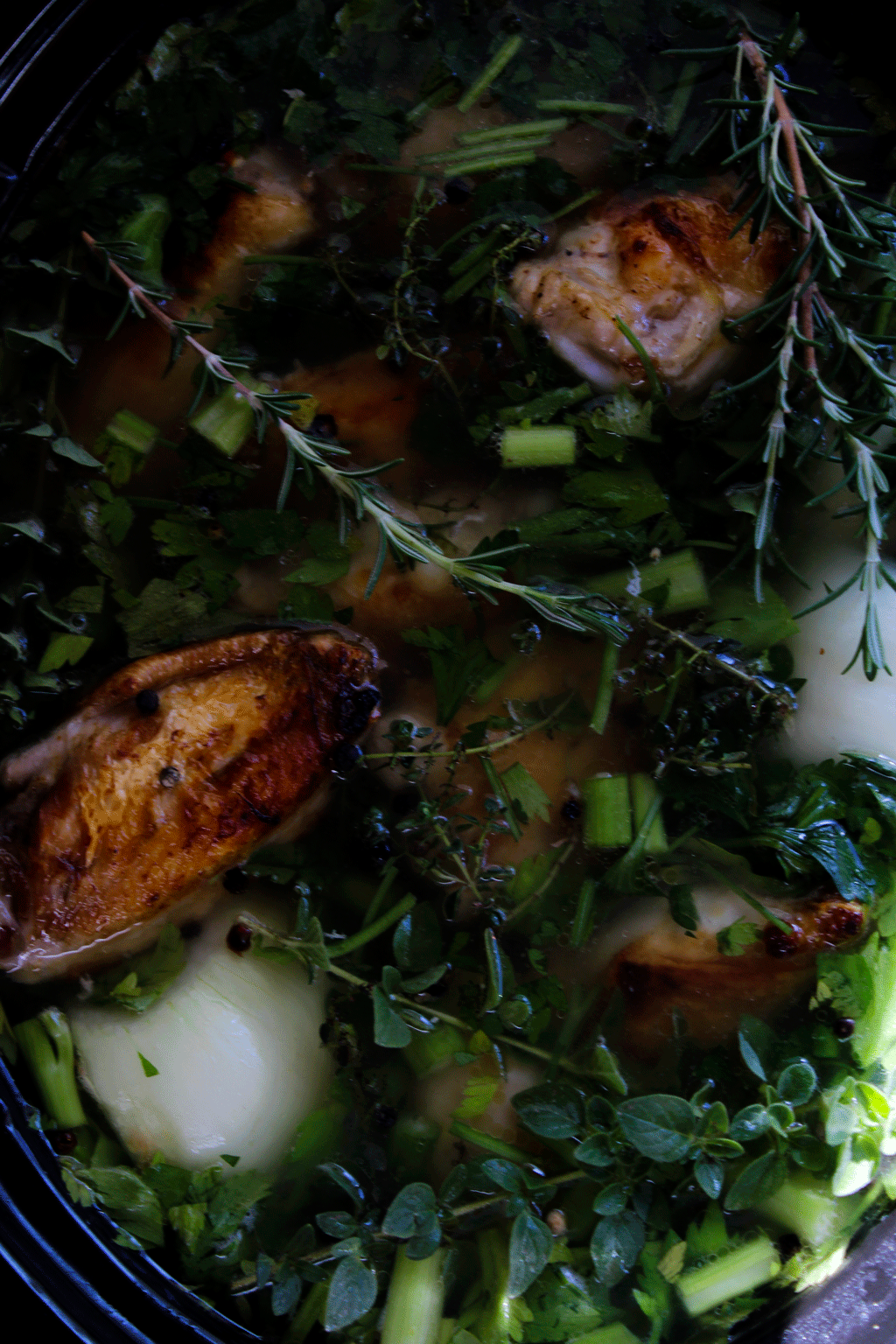Anatomy of a Beautiful Bone Broth
Anatomy of a Beautiful Bone Broth
Chicken Stock | Bone Broth
YEILDS 8 CUPS OF STRAINED STOCK
2 qts. cold water
1 Tbsp. lemon juice (or apple cider vinegar)
2 lbs. chicken wings with tips
1 large onion, peeled & quartered
2 carrots, rinsed & quartered
tops & leaves of a head of celery
1/3 end of a bunch of parsley, the stems with some leaves (in a stock, you use the less desirable parts, ‘the scraps’ reserving the fine leaves for another purpose)
2 sprigs of fresh rosemary
4 sprigs of lemon thyme
3 sprigs of fresh oregano
4 dried bay leaf
1 Tbsp. of pepper corns
1 Tbsp. salt
Roast wings in a hot oven (450f) for 20 minutes. Combine all ingredients in a crock pot, instant pot or a large sauce pot. *Simmer for 3 hours. Strain stock through a fine mesh strainer. Cool to 70f. Refrigerate or freeze according to use.
*Define simmer. The Chef I trained under, Chef Brad Peters, referred to it this way. Simmer is to boiling as smiling is to laughing. Thus, you want your stock smiling. Not laughing. I thought that a brilliant enough analogy to share.Stock.
WHAT IS THE VALUE OF KNOWING HOW TO CREATE A FLAVORFUL STOCK?
Stock consists of bones cooked down with mirepoix & herbs into a flavorful broth. A necessity in the kitchen, it serves as a basis for soups & sauces. It is also a great stand alone. Sipping a cup of hot broth warms us head to toe. If we are feeling under the weather, nothing is quit as soothing or relaxing thanks to the natural tryptophan found in poultry. Collagen (a form of protein) released from the bones is excellent for hair, nails & digestive system. The properties of a good bone broth can aid in weight loss as well as help our bodies recover from surgery or our muscles from exercise. It’s a highly valued staple in the Keto diet as well as the Paleo diet.
CHARACTERISTICS OF AN EXCELLENT STOCK.
A quality stock should deliver a full mouth feel from a generous amount of natural gelatin derived from the bones. I recommend chicken wings for chicken stock as they have a great deal of cartilage & they are the least amount of work. Simply roast for 20 minutes or so in a hot oven or pan fry until skin is crisped up. Alternately, use a roasted carcass. By this I do not mean the bones from a rotisserie chicken, although this may give you some flavor it will contribute little in the way of body & gelatin as it has already given what it has to give. I’m talking about carving a whole raw chicken (reserving the the hind quarters & breast for another purpose) & roasting up the carcass with the wings in a very hot oven (450f) for about 20 minutes. The whole point & benefit of a bone broth is the bones. I do not recommend putting completely raw chicken directly into the broth as it tends to cloud up your stock with impurities. So either roast, pan fry or cook in a pot of boiling water for 5 minutes or so to remove impurities. My preference is roasting. It’s less time consuming & yields a nice roasted flavor profile to the finished stock. For a rich beef stock I recommend ox tail (which is taken from a cows tail, not ox) or neck bones using any of the methods above to remove impurities.
A good stock should be rich & flavorful. This comes from the roasting of the bones as well as mirepoix & herbs. To salt or not to salt? Most chefs do not add salt to their stocks because they are most often used in conjunction with a recipe that adds salt. Not adding salt to the actual stock gives them greater control of the recipes out come. As for me, I salt my stock. Mainly because I use a great deal of it for simply sipping therefor I want it properly season from the go. If I use it in a recipe, say a soup, I know that I will have to adjust the amount of salt in the recipe.
Adding mirepoix (onion, celery, carrot) contributes to flavor, nutrients as well adding body to your stock. I peel my onion & quarter. Celery, you can use scraps such as celery leaves & less desired stalks, rinsed & cut into chunks. Carrots simply need to be rinsed or scrubbed of possible debris, not need to peel, cut into chunks. Most stocks do not contain garlic as it tends to overwhelm. I add garlic to mine because I am a garlic lover & it has wonderful medicinal qualities. The addition of herb & spices serves to add complexity as well as lending an earthy balance to your stock. Minimum, you need parsley. I use a combination of parsley, rosemary, lemon thyme & oregano with bay leaf & pepper corns. Some chefs tie these up in a sachet of cheesecloth with cooking twine & drop it into the stock so it can later be removed. This is referred to as a bouquet garni. Personally, I free float my herbs & aromatics, as the broth gets strained in the end anyway & I feel it adds to the potency.
THE MAKING OF A STOCK
A few basic ingredients & your stock simmers away in silent submission in a corner of the kitchen requiring no attention. Though there are decent quality bone broths on your grocers shelves, nothing compares to fresh homemade bone broth. Not in flavor, not in quality.

